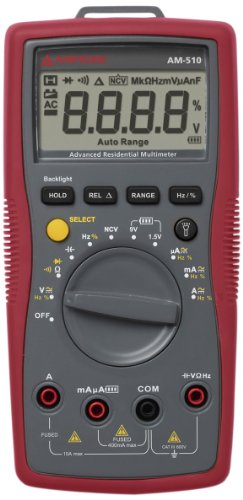
Amprobe AM-510 Commercial/Residential Multimeter with Non-Contact Voltage Detection by Amprobe 
The Amprobe AM-510 digital multimeter with built-in non-contact voltage detector is an average-sensing, auto- or manual-ranging meter for measuring current, voltage, resistance, capacitance, frequency, microcurrent, and duty cycles in commercial and home repair and electrical testing applications. The meter comes with a set of detachable test leads that measure alternating current (AC) and direct current (DC) to 10 amp, AC voltage and DC voltage to 600 volts (V), resistance to 40 megaohms, capacitance to 100 microfarads, frequency to 10 megahertz (MHz), microcurrent to 4,000 microamp, and duty cycles to 99%. The meter's non-contact voltage detector senses AC voltage without making contact with the circuit. A built-in flashlight illuminates dark areas of the work environment. The battery test feature checks the amount of charge remaining in standard 1.5V and 9V batteries. The microamp reading identifies current changes in flame detector applications. The backlit liquid crystal display (LCD) is visible in low light. The relative zero mode stores a reading in memory to use as a zero point for subsequent readings, allowing for quick comparison of readings. The hold function keeps a reading on the display, even after the meter is disconnected. An audible continuity sensor confirms that the circuit conducts electricity, and a diode test detects whether the circuit's diodes work properly. An auto power-off mode turns off the unit after 30 minutes of non-use to conserve battery life, and a low-battery indicator signals when the meter's batteries need to be replaced. The back of the meter has a tilt stand that allows the meter to be propped on a surface for hands-free use. A probe holder on the body of the meter stores probes when not in use.
This average sensing, or average responding, meter provides accurate readings when measuring linear loads, such as standard induction motors and incandescent lights, where the current or voltage has a sinusoidal waveform. Two ranging modes (auto or manual) offer a range of operator control when taking readings. When turned on, the meter is in auto-ranging mode and automatically selects the correct operating range for the property being measured. It can be switched to manual-ranging mode, which allows the operator to choose the appropriate operating range. The meter has a 4,000-count (3-3/4 digit) liquid crystal display (LCD) that can display up to 3,999 units before the operating range needs to be changed. It meets International Electrotechnical Commission (IEC) safety standard 61010 and is certified for category III installations up to 600V (which covers items used with enclosed building circuit installations, such as service panel parts, branch circuits, and fixed installations that are connected directly to a building's AC power supply).
Specifications
| Maximum alternating current (AC) input | 10 amp | 10 amp |
| Maximum AC voltage input | 600 volts (V) |
| Maximum DC voltage input | 600V |
| Maximum resistance detected | 40 megaohms |
| Maximum capacitance detected | 100 microfarads |
| Maximum frequency detected | 10 megahertz (MHz) |
| Maximum AC microcurrent | 4,000 microamp |
| Maximum DC microcurrent | 4,000 microamp |
| Non-contact AC voltage detection range | 90 to 600V |
| Duty cycle measurement range | 0.1 to 99% |
| Power supply | 9V 6F22 or NEDA1604 battery (one, installed) |
| Fuses | 0.5 amp/600V ceramic fast-blow fuse (one, installed) and 10 amp/600V ceramic fast-blow fuse (one, installed) |
| Standards met | European Conformity (CE); International Electrotechnical Commission (IEC) and European Normal (EN) safety standard 61010-1; N10140 Australia; Canadian Standards Association (CSA) |
| Weight | 0.78 lb./354 g |
| Meter dimensions | 7.2 x 3.5 x 1.8 inches/182 × 90 × 45 mm (H x W x D) |
H is height, the vertical distance from the lowest to highest point; W is width, the horizontal distance from left to right; D is depth, the horizontal distance from front to back.
Multimeters are electrical test meters that measure multiple properties of an electrical circuit, such as current, voltage, resistance, capacitance, and continuity. Available in handheld or benchtop models, multimeters diagnose electrical problems in electrical equipment, wiring, and power supplies. A variety of probes, clamps, and leads can be used to connect the meter to a circuit or device. Multimeters display information either in analog or digital form. Factors that influence meter choice include the electrical properties to be measured, the anticipated range of results, and the desired level of protection against transient voltages. Safety ratings are based on the International Electrotechnical Commission's (IEC) standards for low-voltage test equipment. IEC 61010 delineates four overvoltage installation categories. In general, a meter with a category IV rating will provide more protection against transient voltages than a meter with a lower category rating.
Amprobe manufactures electrical testing equipment for commercial, industrial, and home use. The company was founded in 1948 and is headquartered in Everett, WA.
What’s in the Box?
- Amprobe AM-510 average-sensing digital multimeter
- (1) Set of test leads
- (1) 9V 6F22 battery (installed)
- Carrying case
- Instructions
Amprobe AM-510 Commercial/Residential Multimeter with Non-Contact Voltage Detection Feature

No comments:
Post a Comment